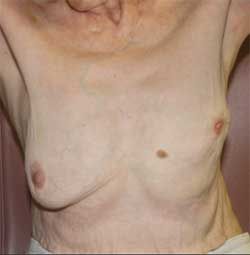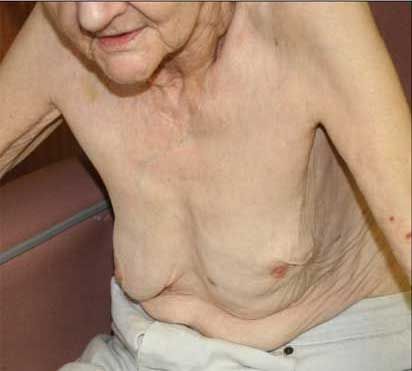A Woman With Markedly Asymmetrical Breasts
A 77-year-old woman with Alzheimer dementia admitted to a behavioral hospital because of intractable agitation. Denies prior breast problems. Subsequently, her daughters state that she had a diagnostic breast biopsy 5 years earlier; diagnosis confirmed by review of pathology report. Patient has adamantly and consistently refused further investigation or treatment of breasts.
HISTORY

A 77-year-old woman with Alzheimer dementia admitted to a behavioral hospital because of intractable agitation. Denies prior breast problems. Subsequently, her daughters state that she had a diagnostic breast biopsy 5 years earlier; diagnosis confirmed by review of pathology report. Patient has adamantly and consistently refused further investigation or treatment of breasts.
Has recently lost weight unintentionally.
PHYSICAL EXAMINATION
Distressed woman. Normal vital signs. No palpable lymphadenopathy. Chest without crackles, wheezes, or rhonchi. No tenderness over the spine. Normal neurological findings.
Sometimes speaks sociably and lucidly; at other times inconsolable.
What’s Your Diagnosis?
(answer on next page)
ANSWER: LOCALLY ADVANCED BREAST CANCER
The first crucial question is “Which side is normal?” and this is never trivial: one can so easily construe the diseased side as the intact one. In this patient the more pendulous right breast contained no mass. It has an ordinary- appearing nipple-areolar complex.

Figure 1 – From this angle, the severe flattening of the cancerous breast becomes manifest; on an earlier view, its loss of pendulousness had been prominent. The medial surface of the left breast shows an innocuous brown seborrheic keratosis. Tortuous superficial vein on chest wall is variant of normal. Old brown ecchymoses are conspicuous on the arms.
The left breast is retracted (Figure 1); it rides high on the chest wall. Its nipple is flattened and the areola has shrunken almost to the point of vanishing (Figure 2). Deep wrinkles (“puckering”) radiate from the nippleareolar complex, due to stromal tethering, while the intact right breast lacks any such feature. Laterally, the left breast surface irregularity becomes more confluent (see Figure 2). For all these reasons, one infers and concludes that the left breast is the abnormal one even before palpating the large hard mass that has replaced almost all its parenchyma.

Figure 2 – With the left nipple-areolar complex in view, lateral puckering is emphasized. Flattening
of nipple is prominent, and the areola appears severely shrunken.
In fact, biopsy had shown infiltrating ductal carcinoma. This woman was free of diagnosed dementia at that time. She steadfastly refused workup or any treatment, after being fully apprised by the surgeon and earnestly entreated by her family.

Figure 3 – With the patient’s arms raised, the axillae become easier to inspect. They appear free of lymphadenopathy, but palpation remains requisite. Infraclavicular fossae stand out further from elevation of arms that raises the clavicles; no masses are seen there.
The axillae appear free of lymph nodes (Figure 3); but of course palpation is the proper means to move from speculation and hypothesis to assertion.
PUCKERING AND NIPPLE RETRACTION
We most often think of cancer as enlarging the breast rather than shrinking it; but either alteration can result. Retraction of breast tissue with or without a palpable mass suggests cancer.1 Several non-neoplastic differential diagnoses further tax the interpretation of these changes in contour.
Decades after menopause, because of loss of estrogen effect, fat replaces the glandular portion of the breast. Resultant hormonally based atrophy could be confused with puckering; perfect symmetry and the lack of a mass will help reassure both patient and examiner that the change is not pathological.
Breast abscess or mastitis can cause retraction. Associated signs of inflammation are usually prominent (eg, erythema); the most common setting is lactation.2 A tiny fraction of breast cancers mimic inflammation (so-called inflammatory breast cancer or carcinoma erysipelatoides).3Chronic mastitis is a distinct entity wherein repetitive damage creates scarred lumps and knots that are easily mistaken for carcinoma.
Fat necrosis can follow trauma (often trivial), resulting in a poorly delineated area of induration and fibrosis, sometimes with puckering of the overlying skin and nipple retraction. Localized scleroderma, morphea, in the absence of systemic sclerosis can produce a breast mass with retraction and puckering.4
WHY DID THIS ADVANCED CANCER NOT ULCERATE?
Ulceration of the overlying skin and hard immobile axillary lymph nodes are late signs of carcinoma. The absence of such features in this case and in others must never lull us into regarding a breast abnormality as innocuous. Otherwise, we will diagnose the disease only in advanced stages, exacerbating a trend caused by the anxiety that so often imposes a delay of a year or more from finding a lump to seeking a medical opinion.5
The lack of ulceration in this locally advanced breast cancer speaks to the disease’s sometimes respecting fascial or other local boundaries even during wide infiltration of mammary fat and tissue.
The absence of clinically evident distant metastases underscores the frequent long delay in lymphohematogenous dissemination. Breast cancer is notorious for variation in natural history in this domain as in so many others.
BREAST EXAMINATION IN CONTEXT
Mortality from breast cancer has fallen over the past several years. This has been attributed in part to increased use of breast self-examination and of mammography, along with improvements in adjuvant and other therapies. Clinical breast examination, mammography, and fine-needle aspiration augment each other in screening for early carcinoma of the breast.6,7
Diverse breast examination techniques are in use.8,9 The pads of the fingers enhance specificity in palpating the breast as compared to the fingertips: They appear to reduce our perceiving normal nodularity of the breast as lumps.
Certainly, diagnosis does not arise from a single finding or in the blink of an eye (the old German term of augenblick diagnosis10). Rather, conglomeration of the history and physical findings generates and then tests hypotheses, or most precisely, determines whether the null hypothesis (“there is no breast cancer here”) is tenable. Breast examination is of course supplemented by palpating the axillae, though false-positive as well as false-negative results are well known; for example, sinus histiocytosis of the nodes may give a false impression of metastases in a patient with breast cancer, but is associated with improved prognosis. Because clinically cancer may mimic non-cancer and vice versa, histopathological or cytopathological evaluation is often required. Not only can one experience the relatively familiar falsenegative clinical examination, when the mammogram saves the day, but one can also have a false-negative mammogram with a palpable cancer,11-13 and a clinical finding that one feels absolutely certain must be cancer, but that turns out to be merely inflammatory.14
COFFEE WITH A FRIEND: A PRACTICAL AND KINDLY APPROACH
Dementia alters diagnosis and management of all ailments in the afflicted patient. First there is the question of diagnosis: One could wonder if microscopic brain or meningeal metastases contributed to cognitive dysfunction in this case. However, clinical duration and the lack of other findings of systemic metastases make this most unlikely. One could also wonder if a paraneoplastic syndrome or other complication of cancer were contributing to agitation; yet the only common mechanism would be pain and hypercalcemia from bone metastases. We would not expect symptomatic hypercalcemia without bone pain; and an ionized calcium level was normal.
Imagine the world of this elderly woman in the foreign territory of a health care institution: all sorts of people, many in long white coats, walk in and out of the room talking what sounds to her like gibberish. Because of her dementia, she can no longer perform selfcare, and this loss long predates her breast cancer. Does she have the capacity to understand any management plans we make for her? The actions of utmost comfort to this woman are those providing immediate gratification or ease, based on close knowledge of her personal tastes.
We had the privilege of witnessing truly expert care of a person with advanced dementia, achieving not just the cooperation that we required, but an immediate and sustained turnaround of affect that changed the patient’s experience of the moment. Instantaneous experience is what matters most to her. Sometimes this is the only thing we can accomplish for a person in this scenario.
The patient, along with her family, had strongly agreed with our request to take clinical photographs for teaching. Their altruistic wish to afford help to others had been paramount. However, on the day we stopped by with the camera, the patient became agitated and nonselectively hostile toward staff. The exercise of our clinical skills to try to distract, persuade, or mollify her proved unavailing. We prepared to leave the unit for the day: we never want to make a patient unhappy, least of all when we are not forced to do so by exigent circumstances, or compelled because individual benefit outweighs discomfiture.

Figure 4 – Devoted nurse sets patient at ease with body posture, tone, words, and gifts of coffee and cake.
The nurse manager on the unit saw our frustration and said, “I can comfort her and make this happen.” She then procured a slice of coffee cake, which she knew the patient loves to eat; sat with her and talked most lovingly while the patient savored her treat; and gave her coffee to drink (Figure 4). This proved utterly soothing; the continued presence of the physicians did not disturb this interaction. Thereafter the nurse manager offered to help the patient change her now crumbcovered blouse, and asked if while this were ongoing we might take the photographs; she readily and unhesitatingly assented, and afterward remained in the best of moods.
AFTERWARD
This patient remains on the dementia unit. Some of her days are better than others. Her weight loss relates to dementia. She is still free of discernible symptoms and signs of disseminated cancer. Ongoing evaluation is principally by bedside examination. This accords closely with her own preferences and those of her well-informed, strongly supportive daughters. Her preference to avoid certain interventions rules the choice of management and diagnosis, on a unit where her personhood and dignity are respected, and where she is loved.
Schneiderman H, Kanaparthy N. Locally advanced breast cancer with retraction of the affected breast and disfigurement of the nipple-areolar complex. CONSULTANT. 2008;48:968-977.
References:
REFERENCES:
1
. Schneiderman H. Breast cancer with unilateral nipple inversion and no palpable mass.
Consultant.
1990;30(10):39-40.
2
. Schneiderman H. Acute mastitis and its mimics. Consultant. 1994;34:1711-1712.
3
. Falagas ME, Vergidis PI. Narrative review: diseases that masquerade as infectious cellulitis.
Ann Intern Med.
2005;142:47-55.
4
. Schneiderman H. Morphea (localized scleroderma) of the breast.
Consultant.
1999;39:2057-2058.
5
. Hackett TP, Cassem NH, Raker JW. Patient delay in cancer.
N Engl J Med.
1973;289:14-20.
6
. Steinberg JL, Trudeau ME, Ryder DE, et al. Combined fine-needle aspiration, physical examination and mammography in the diagnosis of palpable breast masses: their relation to outcome for women with primary breast cancer.
Can J Surg.
1996;39:302-311.
7
. Hermansen C, Skovgaard PH, Jensen J, et al. Diagnostic reliability of combined physical examination, mammography, and fine needle puncture (“triple-test”) in breast tumors: a prospective study.
Cancer.
1987;60:1866-1871.
8
. Byrd BF. Close-up: standard breast examination.
CA-CJC.
1974;24:290-293.
9.
Barton MB, Harris R, Suzzane WF. Does this patient have breast cancer?: the screening clinical breast examination: should it be done? How?
JAMA
. 1999;282:1270-1280.
10
. DeGowin EL, DeGowin RL. B
edside Diagnostic Examination.
4th ed. New York: Macmillan Publishing Company; 1981:5,35.
11
. Hall FM, Connolly JL, Love SM. Lipomatous pseudomass of the breast: diagnosis suggested by discordant palpatory and mammographic findings.
Radiology.
1987;5:463-464.
12
. DeNeef P, Gandara J. Experience with indeterminate mammograms.
West J Med.
1991;154:36-39.
13
. Langlands AO, Tiver KW. Significance of a negative mammogram in patients with a palpable breast tumour.
Med J Aust.
1982;1:30-31.
14
. Schneiderman H. Mastitis mimicking Paget disease of breast.
Consultant.
2003;43:734-742.